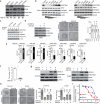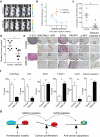Synthetic lethality by targeting EZH2 methyltransferase activity in ARID1A-mutated cancers
- PMID: 25686104
- PMCID: PMC4352133
- DOI: 10.1038/nm.3799
Synthetic lethality by targeting EZH2 methyltransferase activity in ARID1A-mutated cancers
Abstract
The gene encoding ARID1A, a chromatin remodeler, shows one of the highest mutation rates across many cancer types. Notably, ARID1A is mutated in over 50% of ovarian clear cell carcinomas, which currently have no effective therapy. To date, clinically applicable targeted cancer therapy based on ARID1A mutational status has not been described. Here we show that inhibition of the EZH2 methyltransferase acts in a synthetic lethal manner in ARID1A-mutated ovarian cancer cells and that ARID1A mutational status correlated with response to the EZH2 inhibitor. We identified PIK3IP1 as a direct target of ARID1A and EZH2 that is upregulated by EZH2 inhibition and contributed to the observed synthetic lethality by inhibiting PI3K-AKT signaling. Importantly, EZH2 inhibition caused regression of ARID1A-mutated ovarian tumors in vivo. To our knowledge, this is the first data set to demonstrate a synthetic lethality between ARID1A mutation and EZH2 inhibition. Our data indicate that pharmacological inhibition of EZH2 represents a novel treatment strategy for cancers involving ARID1A mutations.
Figures






Comment in
-
Cancer: An epigenetic target for synthetic lethality.Nat Rev Drug Discov. 2015 Apr;14(4):236. doi: 10.1038/nrd4589. Nat Rev Drug Discov. 2015. PMID: 25829276 No abstract available.
References
Publication types
MeSH terms
Substances
Associated data
- Actions
Grants and funding
LinkOut - more resources
Full Text Sources
Other Literature Sources
Medical
Molecular Biology Databases

